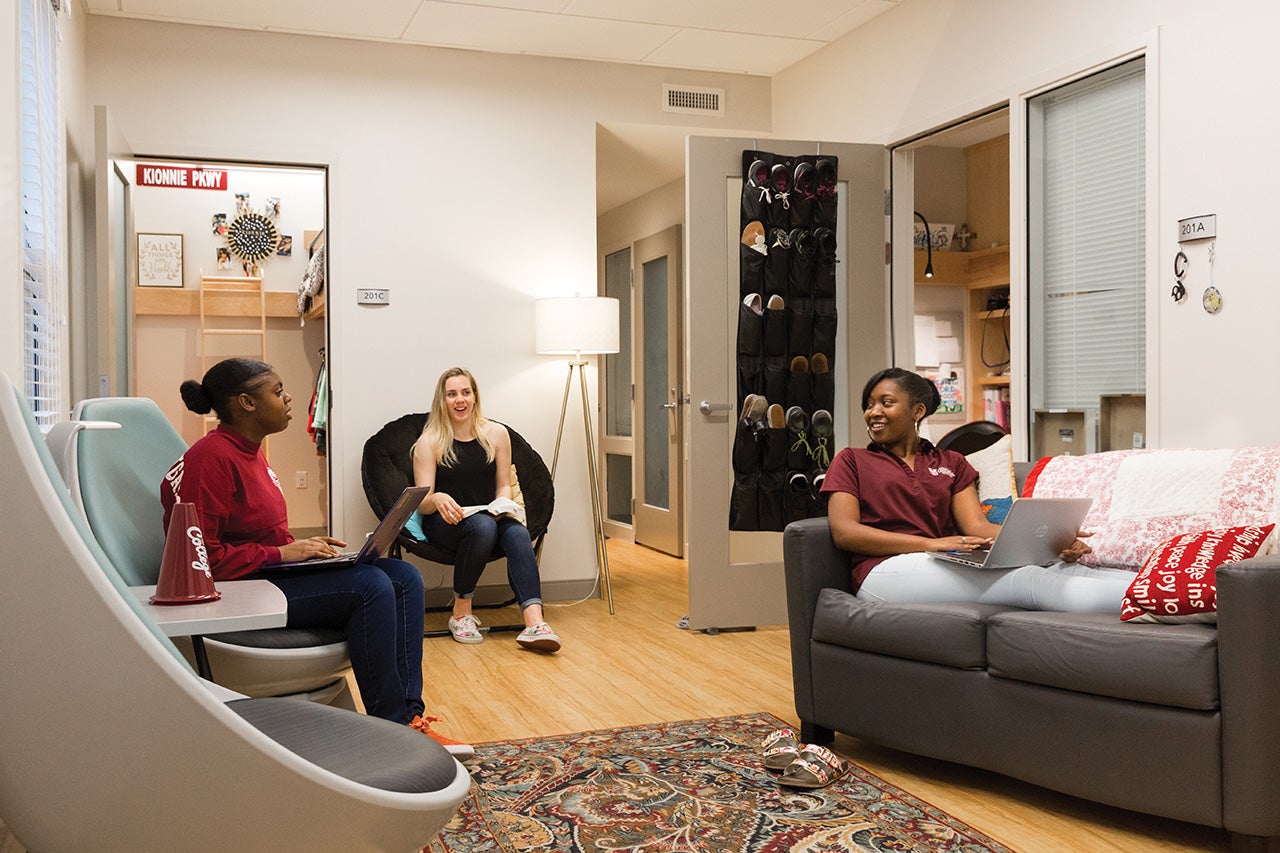We all know that big things come in small packages. And, at the newly renovated Rutledge Rivers Residence Hall, what has come out of these “tiny” living spaces is a pretty big deal.
As one of the country’s first student residences to follow the tiny living model, the new Rutledge Rivers is doing more than setting standards for the latest in architectural trends: It’s cutting back on operating costs for the College, lowering the cost of living for its residents and reducing the carbon footprint for the campus as a whole.
The biggest impact of the residence hall’s new layout, however, is happening on the inside: It’s building a sense of community.
“We wanted to best utilize the existing building and develop a setup that would encourage social interactions and enhance the community and the student-living experience,” says Melantha Ardrey ’02, director of residence life at the College. “It’s a cutting-edge design approach to encouraging relationships among students and creating a community within their own homes.”
And that’s no small matter – especially for today’s students, many of whom spend more time on social media than they do in social settings.
“Students today spend a lot of time on their devices, in front of screens,” says Ardrey, adding that, despite that trend, students report they’d like more opportunities to socialize face to face. “They want their own space, but they also want more social interaction. Rutledge Rivers gives them both: They get privacy in their sleeping pods, but the layout forces them to come out and be part of the larger community.”
That little push is often exactly what students need, especially at first.
“One of the biggest challenges for new students on college campuses is meeting new people,” says Rutledge Rivers Residence Hall Director Lillie Chamblee. “Tiny living offers a solution to this struggle by arranging on-campus residents in close living proximity and creating useful, comfortable and stylish areas for mingling.”
Rutledge Rivers certainly offers plenty of flexible gathering areas, including a community room, a laundry room and a room for RA programs – none of which was part of the original building. Even so, while typical on-campus student apartments average 350 square feet per student, Rutledge Rivers’ apartment-style living and public spaces average out to 252.
“We’ve managed to maximize the use of the square footage while still making it a comfortable, open-feeling place to live,” says Ardrey, giving credit to Little Diversified Architectural Consulting, the firm tasked with not just bringing the 27,800-square-foot Rutledge Rivers up to code with ADA-compliant features and renovations to the plumbing and HVAC systems, but also redesigning the 1973 residence hall for the modern student. “Their approach makes the most of the footprint of the existing building while also increasing the number of students we can accommodate.”
In fact, the number of beds in Rutledge Rivers increased from 103 to 109: a feat accomplished by using every available square inch in the common areas and within the living suites themselves. The 890-square-foot, five-person suites have two double bedrooms and a single bedroom, and the 1,085-square-foot, six-person suites have two doubles and two singles. Each suite has two bathrooms and a kitchenette with a two-burner induction stovetop, a sink and a full-size fridge.
And don’t forget the living rooms. With all the bedrooms oriented around it, the living room is designed to be the center of life for each suite, lending it that sense of community, warmth and comfort, too.
“It is totally intentional that the living rooms all feature big windows to make them bright and sunny,” says Amy Orr ’95, director of business and auxiliary services, explaining that while some of the sleeping pods don’t have windows, they are situated to get sunlight from the living room instead. And that’s OK, she says, because – at 75 square feet for the single-occupancy rooms and 115 square feet for the doubles – the bedrooms aren’t meant for hanging out anyway. “The sleeping pods are really just that: places to sleep and keep your privacy when you need it.”
What the sleeping pods lack in sunlight and space, however, they make up for in convenience. Everything is right there, built in for efficiency: shelving, hanging clothing storage, chest of drawers and desks – and, of course, the ladders that lead to the lofted twin beds, which are extra long and have outlets and USB ports within reach, an idea the architects took from students involved in the design process.
“We engaged students from the Residence Hall Association during the design phase to get their feedback and ideas,” says Orr. “Ultimately, the students are the ones who matter here – they’re the ones who have to live there.”
And, according to the ones living there now, the students are loving it.
“This is where everyone wants to live,” says freshman Rutledge Rivers RA Kionnie Epps. “It’s new and clean, and it’s just a really cool layout. You have your own space, but you also have a lot of areas you can go and hang out. All my friends in the other residence halls are jealous.”
“This is where everyone wants to be,” agrees Ardrey, adding that Rutledge Rivers is especially attractive to the most sustainability-focused students. “It’s not just a pretty space that builds community. It’s an environmentally friendly and sustainable space that provides an opportunity for intentional, sustainable living. And that’s something that this generation of students is aware of.”
Indeed, for this generation and many more to come, that’s a pretty big deal.





